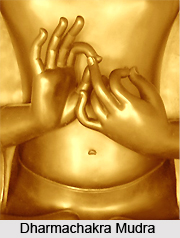 Dharmachakra Mudra is another prominent mudra among others. Dharmachakra in Sanskrit means `Wheel of Dharma`. This Mudra is of turning the wheel of the Dharma or teaching. This mudra is mainly associated with Buddha`s first teaching. In Dharmachakra Mudra, the thumb and index finger of both hands touch at their tips to form a circle. This circle symbolizes the Wheel of Dharma, or in metaphysical terms, the merger of method and wisdom.
Dharmachakra Mudra is another prominent mudra among others. Dharmachakra in Sanskrit means `Wheel of Dharma`. This Mudra is of turning the wheel of the Dharma or teaching. This mudra is mainly associated with Buddha`s first teaching. In Dharmachakra Mudra, the thumb and index finger of both hands touch at their tips to form a circle. This circle symbolizes the Wheel of Dharma, or in metaphysical terms, the merger of method and wisdom.
In Hindu mythology, the Dharmachakra or the wheel embodies completion or the wheel of life that guides people through a diversity of experiences. However, there are two wheels and this indicates the teaching of reincarnation. The hands form two wheels. The left middle finger (Saturn) represents the transition from this world into the next that is from death and birth. The left hand, which points to the heart, symbolizes the inner world of the body. The right hand indicates surrounding world. The inside and outside must be in harmony with each other. This Dharmachakra Mudra also is used for eternal change.
Practice of Dharmachakra Mudra
In order to practise Dharmachakra Mudra, one will have to raise both hands in front of one"s chest with right hand a little higher than the left. Join the thumbs and index fingers of each hand. The palm of the left hand faces the heart, and the back of the right hand faces the body. The left middle finger touches the place where the thumb and index finger of the right hand form a closed circle. While forming it, breathing should be very deep, slow, and fine. A focus should be on how the three fingertips are touching each other. It is possible for a person to notice a change in one`s mood after performing this Dharmachakra Mudra. This mudra can be practiced at home as well as office.
Benefits of Dharmachakra Mudra
•The practice of this mudra ensures an eternal change within the person.
•It also brings change in one`s mood for the betterment.
•It ensures a positive approach towards life.
•It calms the mind and helps one to remain positive in life.
•It improves concentration power.




















